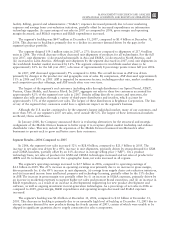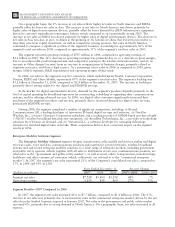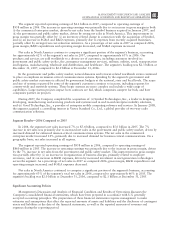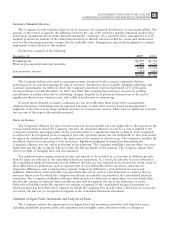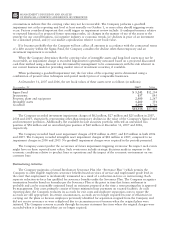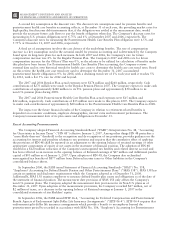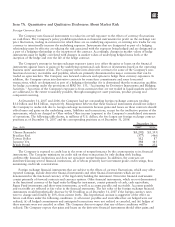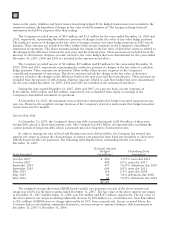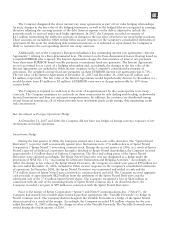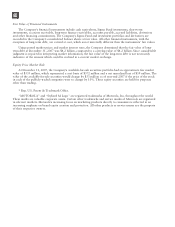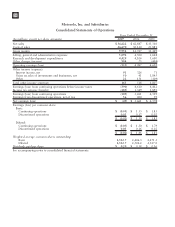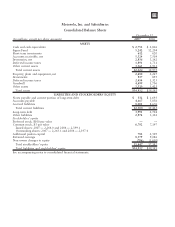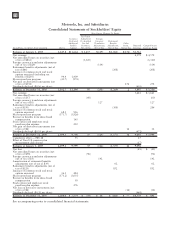Motorola 2007 Annual Report Download - page 77
Download and view the complete annual report
Please find page 77 of the 2007 Motorola annual report below. You can navigate through the pages in the report by either clicking on the pages listed below, or by using the keyword search tool below to find specific information within the annual report.
Benefits Other Than Pensions” or APB Opinion No. 12, “Omnibus Opinion—1967” (“the Statements”) based on
the substance of the agreement with the employee. Under the provisions of these Statements, a liability should be
accrued equal to the actuarial present value of the future death benefit over the service period. EITF 06-4 is
effective for fiscal years beginning after December 15, 2007. The Company will adopt EITF 06-4 as of January 1,
2008 and anticipates that the adoption of this pronouncement will result in an increase in Other liabilities of
approximately $50 million with the offset reflected as a cumulative-effect adjustment to Retained earnings.
In September 2006, the FASB issued SFAS No. 157, “Fair Value Measurements” (“SFAS 157”). SFAS 157
defines fair value, establishes a framework for measuring fair value as required by other accounting
pronouncements and expands fair value measurement disclosures. SFAS 157 is effective for fiscal years beginning
after November 15, 2007. In February of 2008, the FASB issued FASB Staff Position 157-2 which delays the
effective date of SFAS 157 for non-financial assets and liabilities which are not measured at fair value on a
recurring basis (at least annually) until fiscal years beginning after November 15, 2008. The Company is currently
evaluating the impact of SFAS 157 on the Company’s consolidated financial statements.
In February 2007, the FASB issued SFAS No. 159, “The Fair Value Option for Financial Assets and Financial
Liabilities—Including an amendment of FASB Statement No. 115” (“SFAS 159”). SFAS 159 permits entities to
elect to measure many financial instruments and certain other items at fair value. Unrealized gains and losses on
items for which the fair value option has been elected will be recognized in earnings at each subsequent reporting
date. SFAS 159 is effective for fiscal years beginning after November 15, 2007. The Company is currently assessing
the impact of SFAS 159 on the Company’s consolidated financial statements.
In December 2007, the FASB issued SFAS No. 160, “Non-Controlling Interests in Consolidated Financial
Statements an amendment of ARB No. 51” (“SFAS 160”). SFAS 160 establishes new standards for the accounting
for and reporting of non-controlling interests (formerly minority interests) and for the loss of control of partially
owned and consolidated subsidiaries. SFAS 160 does not change the criteria for consolidating a partially owned
entity. SFAS 160 is effective for fiscal years beginning after December 15, 2008. The provisions of SFAS 160 will
be applied prospectively upon adoption except for the presentation and disclosure requirements which will be
applied retrospectively. The Company does not expect the adoption of SFAS 160 will have a material impact on
the Company’s consolidated financial statements.
In December 2007, the FASB issued SFAS No. 141(revised 2007) (“SFAS 141R”), a revision of SFAS 141,
“Business Combinations.” SFAS 141R establishes requirements for the recognition and measurement of acquired
assets, liabilities, goodwill, and non-controlling interests. SFAS 141R also provides disclosure requirements related
to business combinations. SFAS 141R is effective for fiscal years beginning after December 15, 2008. SFAS 141R
will be applied prospectively to business combinations with an acquisition date on or after the effective date.
Realignment of Segments
As described in a Form 8-K filed on July 17, 2007, the Company has realigned its operations, effective as of
the second quarter of 2007, into the following three business segments in order to better align its operations with
the evolving nature of our customers and served markets: (i) Mobile Devices, (ii) Home and Networks Mobility,
and (iii) Enterprise Mobility Solutions. The Form 8-K filed on July 17, 2007 presented the Company’s segment net
sales and operating earnings for 2006 and first quarter of 2007 reclassified to reflect the presentation of the
realigned segments.
Forward-Looking Statements
Except for historical matters, the matters discussed in this Form 10-K are forward-looking statements that
involve risks and uncertainties. Forward-looking statements include, but are not limited to, statements under the
following headings: (1) “Mobile Device Segment,” about industry growth, including in emerging markets and for
replacement sales, the impact of the segment’s strategy, our exploration of structural and strategic realignment, the
impact from the loss of key customers, the impact from the allocation and regulation of frequencies, the impact of
regulatory matters, the availability of materials and components, energy supplies and labor, the seasonality of the
business, the firmness of the segment’s backlog and the manufacturing location; (2) “Home and Networks Mobility
Segment,” about the potential of the portfolio, including WiMAX, the impact of the separation of set-top security
functionality, 3G licenses and market development, sales and utilization, industry growth, the impact of the
segment’s strategy, the impact of acquisitions, the impact from the loss of key customers, competition from new
and existing competitors, consolidation among providers, iDEN trends, the impact of regulatory matters, the
impact from the allocation and regulation of frequencies, the availability of materials, energy supplies and labor,
69
MANAGEMENT’S DISCUSSION AND ANALYSIS
OF FINANCIAL CONDITION AND RESULTS OF OPERATIONS


